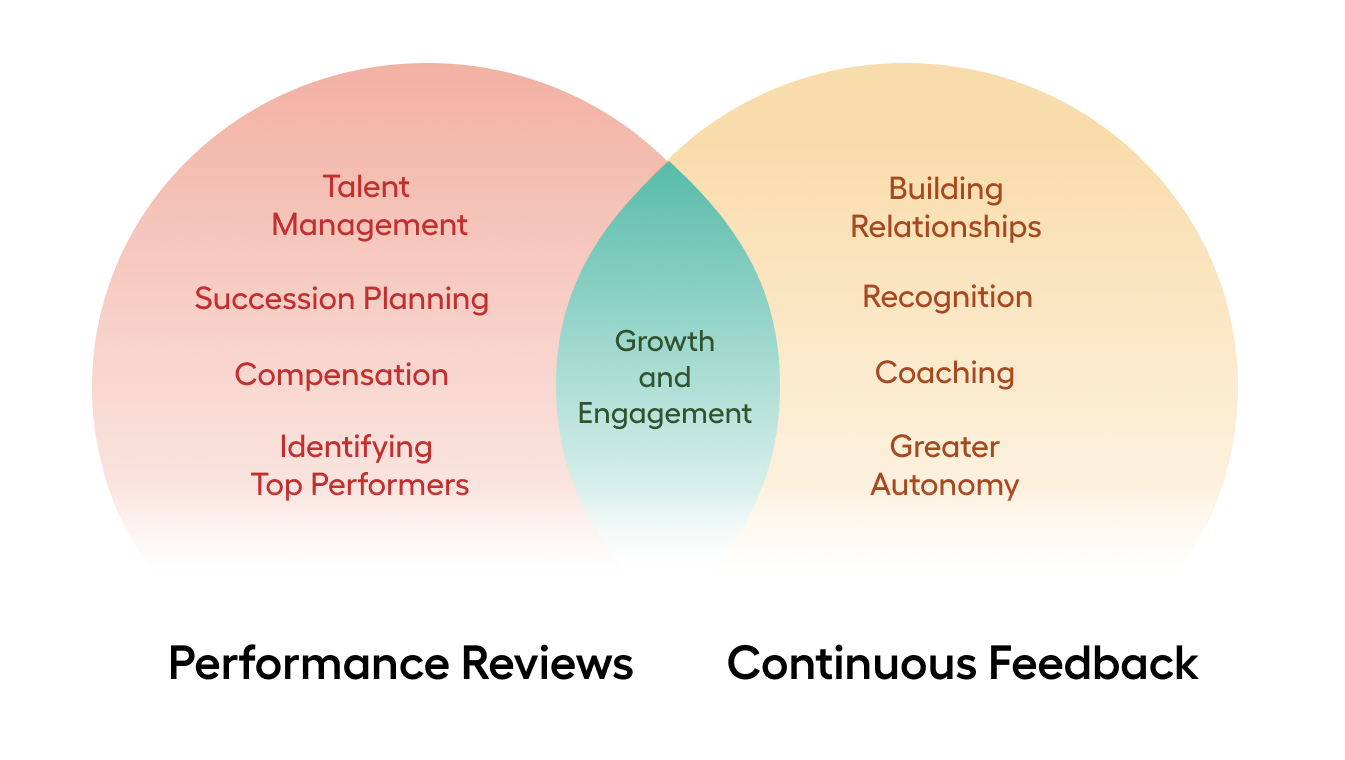Performance management is due for an overhaul. Despite the business value of reviews and feedback, just 5% of managers and 8% of organizations are satisfied with how they approach either.
With that disconnect, it should come as no surprise that HR teams are rethinking performance management. They’ve leaned on two valuable tools, performance reviews and continuous feedback, to improve how they develop their talent.
We’ll dive into the merits of both — and why HR teams shouldn’t look at implementing reviews and continuous feedback as an “either-or” proposition.
Performance Reviews
Performance reviews are the most common approach to performance management, and most employees know to expect them in almost any role. Performance reviews evaluate employee progress on established goals and serve as a benchmark for compensation and promotion decisions. The frequency of reviews varies by organization and is dependent on a number of factors, including goal refresh cycles, level of internal mobility, headcount, and other business characteristics.
Pros
Performance reviews give organizations important insight into the type of work employees are doing and the overall value they bring to the company. Reviews also give employees a chance to know where they stand within their team and the organization as a whole. Apart from these high-level benefits, there are a number of reasons why performance reviews are a core element of performance management:
1. Structure
Performance reviews rely on concrete benchmarks to make accurate assessments of employee performance. By using data to determine how effectively an employee is or isn’t delivering on job competencies and objectives, performance reviews provide much needed structure to the evaluation process. This objective approach is also useful for identifying top performers and employees in need of support, and it indirectly pushes companies to document key factors behind decisions that affect employees, such as compensation and promotions.
2. Planning
Periodic reviews serve as progress markers for employees with an eye on advancement and career development. This is especially true at companies where annual performance reviews are the only performance management process being practiced. Employees want to know if and how their hard work is paying off and helping them move in the right direction professionally. Performance reviews are a chance for managers and direct reports to sync on past results and future expectations, including opportunities for career growth.
3. Combatting Bias
Performance review systems are valuable tools for combating bias and promoting diversity, equity, and inclusion (DE&I) in the workplace. Without the standardized criteria of performance reviews, it’s common for managers to rely on their “gut instinct” when evaluating employees, which can have a detrimental impact on crucial decisions around compensation and promotions. In fact, research shows that organizations that lack a formal performance review process are more likely to exhibit heightened bias against women and people of color. Performance reviews prevent this by ensuring that performance management processes are equitable and fair.
Cons
Despite being a necessary tool for almost every company, performance reviews may have a bad reputation for being stressful or time-consuming. With 78% of employees reporting that they are dissatisfied with their organization’s performance review process, here are a few reasons why reviews shouldn’t necessarily stand alone or simply happen once a year:
1. High Stakes
Performance reviews are a source of anxiety for many employees because they carry so much weight. Performance is directly linked to many important aspects of the employee experience, such as pay, job security, interpersonal relationships, and overall confidence in the workplace. 360 performance reviews allow employees to receive feedback from their peers, but this feedback is often delivered and addressed by only one person –– the manager. This puts a lot of pressure on both managers and employees to create a healthy and positive exchange that leads to progress instead of resentment or discomfort.
2. Inaccurate Representation
When managers and employees are expected to reflect on a year’s worth of work, there are going to be some inevitable challenges. Relying on memory for an annual employee evaluation is a sure-fire way to gloss over important details that help paint a full picture of performance. Data-driven goals are great for tracking certain types of employee progress, but managers should also consider less quantifiable qualities, such as leadership or communication, that add value to the organization. Periodic reviews also leave room for things like recency bias, which is likely a reason why 75% of employees see annual reviews as unfair.
3. Lack of Agility
Your company, team, and employee objectives set the context for performance reviews that take place across your organization. But goals are fluid, and at many companies –– especially ones that are growing quickly –– changing circumstances or business needs are constantly driving goal refresh cycles. Performance reviews that take place on an annual basis can become misaligned with shifting priorities, so it’s worth considering whether your organization needs to implement a more agile approach to performance management.
Continuous Feedback
Companies are increasingly augmenting their performance management process with continuous feedback. This approach creates a culture of ongoing, honest communication between managers and employees. It’s also important to note that continuous feedback includes praise and constructive suggestions, both of which should be given and received freely throughout your organization.
Pros
1. Employee Growth
Instead of focusing solely on performance metrics, ongoing feedback drives discussions around employee growth and development. Adopting a framework of continuous feedback allows employees to take a more active role in setting and meeting personal goals. These conversations also encourage employees to seek training or development opportunities in areas that may not be directly tied to their role but provide immediate value to the organization.
2. Real-time Insights
Performance management frameworks that incorporate continuous feedback eliminate room for recency bias and place emphasis on providing actionable suggestions that can be applied immediately. Rather than waiting months to deal with performance issues, managers and employees can use real-time feedback to course-correct or refresh goals without wasting time or resources in the long-term. New communication technologies have made exchanging real-time feedback easier than ever, allowing for better collaboration between employees and more accurate and timely insights for managers.
3. Improved Engagement
Employees want to know where they stand. In fact, 40% of employed Americans would put more energy into their work if they were recognized more often, which makes a great case for the value of the continuous feedback model. Businesses that prioritize real-time feedback are investing in a better employee experience by promoting transparency and autonomy –– qualities that appeal especially to the Millennial and Gen Z workforce, 63% of whom prefer to receive timely feedback throughout the year. Frequent feedback, both positive and constructive, shows employees that development and recognition are important in the workplace, ultimately driving a more engaged workforce.
4. Stronger Relationships
Establishing a culture of consistent feedback not only engages employees, it also helps with retaining top talent by giving them a sense of ownership over their work. Nearly 60% of employees prefer more recognition over a higher salary — and feedback is valuable channel for building strong relationships between employees, managers, and the business as a whole. The more often feedback is exchanged, the more natural and authentic it feels for your employees. Establishing this trust is crucial when it comes to weathering inevitable rough patches as a united front.
Cons
1. Oversaturation
Having more feedback is better than having too little, but there’s a fine line between feedback that is helpful and feedback that is overwhelming. Continuous performance management models draw data from a wide range of sources, including project management software, time tracking systems, testimonials, and more. Sorting through all of this information can be challenging, and it takes time and awareness to discern which pieces of feedback are valuable for employees and which ones are counterproductive.
2. Implementation
Establishing a continuous feedback culture takes time to implement across an entire organization. For managers, encouraging and demonstrating healthy feedback is a time-consuming responsibility that starts at the team level. But transitioning to a mindset of greater connection and communication at work doesn’t come naturally to everyone, and companies often need to find the right tools to help foster the seamless practice of continuous feedback. Making this cultural shift requires budget and buy-in from leadership.
The Solution: A Hybrid Approach
If your company is in the process of reimagining its performance management program, it’s important to note that the performance review and continuous feedback methods both have something to offer. Most businesses find their performance management sweet spot by using a combination of the two. Augmenting your regular reviews with real-time feedback is a great way to ensure that performance management is transparent, consistent, and prioritized year-round.

The process of balancing performance reviews with continuous feedback is influenced by a variety of factors, such as company size, industry, and culture. Regardless of where your organization stands, here are some universal tips for getting performance management right at your company:
- Link feedback to specific goals at the individual, team, and company level.
- Encourage leadership to set an example for engaging in real-time feedback.
- Create frequent opportunities for sharing feedback, like one-on-ones.
- Develop a system for classifying types of feedback (e.g., project-based vs. skills-based).
- Use a tool for documenting feedback that can be accessed any time.
- Simplify the process of giving and receiving feedback by integrating it with existing tools like Slack.
—
Reviews are a crucial part of the performance management process, but they shouldn’t be the only opportunity employees have to give and receive feedback. Bringing real-time feedback and performance reviews together can drive your overall performance management program throughout the year.
Adopting a performance management software can help companies facilitate regular conversations around employee performance and enable managers to provide relevant support at the right time. To see how Lattice empowers teams to manage and improve performance, schedule a demo today.







